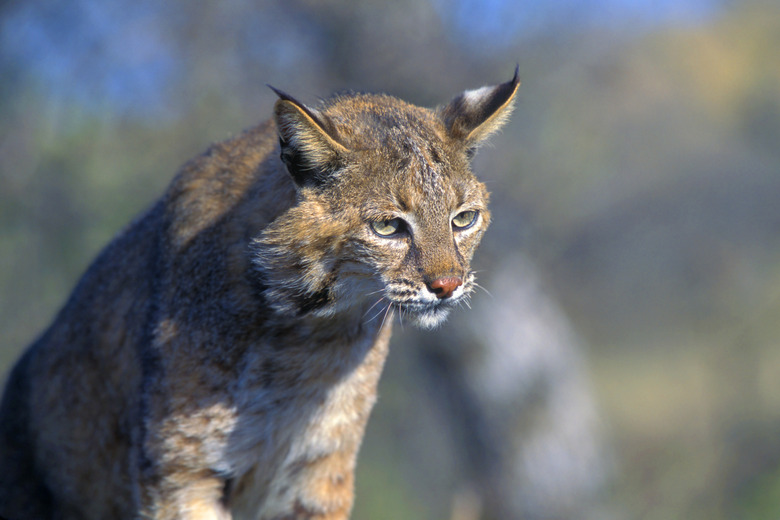The Types Of Wild Cats In Massachusetts
At the time of European settlement, the New England state of Massachusetts harbored three types of wild cats: the **puma** (also known as the cougar, mountain lion, catamount or panther), the Canada lynx and the bobcat.
Of these, only the bobcat remains, the puma and lynx having been extirpated (locally eliminated) through hunting and habitat loss. Sightings of pumas, however, are occasionally reported in Massachusetts, though only two authenticated records from the past few decades exist.
The Only Current Native Wild Cats in Massachusetts: Bobcats
The Only Current Native Wild Cats in Massachusetts: Bobcats
The bobcat is a member of the lynx genus; in fact, the species was historically often referred to as the bay or red lynx, which is a reference, mind you, to its color, not to any connection to the "Bay State" of Massachusetts. Bobcats remain widespread in North America, found from southern Canada into central Mexico and occupying the majority of the Lower 48 states.
Named for the "bobbed" tail it shares with other lynx, the bobcat is two or three times the size of an average housecat, standing roughly 20 inches at the shoulder and weighing 15 to 40 pounds, sometimes more. It ranges in hue from tawny to reddish- or grayish-brown, its coat heavily patterned with black spots and barring. Other prominent characteristics include the tufted pricked ears and pronounced cheek ruff.
Exceptionally adaptable and quite resilient in the face of human activity, bobcats inhabit a wide range of habitats in Massachusetts, from dense coniferous forest and deciduous woodland to shrubland, farmland and even suburban fringes. The species is most common in the less developed, more forested central and western reaches of the state, but it's increasingly reoccupying territory in eastern Massachusetts.
Compared with their more specialized relative the Canada lynx, bobcats are generalist predators, taking a broad spectrum of prey ranging from frogs and lizards to mammals as large as full-grown white-tailed deer. Cottontails, squirrels, mice, voles, grouse, waterfowl and other small- to medium-sized animals typically form the bulk of the bobcat's diet.
Massachusetts’ Other, Vanished Lynx
Massachusetts'
Other, Vanished Lynx
The Canada lynx is a lankier, taller, grayer, bigger-pawed cousin of the bobcat, and it also once roamed parts of Massachusetts, the northeastern U.S. forming the southeastern limit of its historic range.
Primarily an inhabitant of boreal and northern hardwood forest in the region, Canada lynx prey heavily on a single species: the snowshoe hare, which particularly in winter often composes the bulk of the cat's fare.
More dependent on forest than the bobcat and more retiring in the face of human development, the lynx was apparently already rare in the state by the mid-19th century. According to the U.S. Forest Service, late historical evidence of Canada lynx in the Bay State include a 1905 record from Lanesborough and a 1918 one from around Mount Greylock in the Taconics of the far northwest.
Today, the closest significant populations of Canada lynx to Massachusetts reside in **northern Maine,** though these gorgeous wildcats have also reoccupied former range in the north of New Hampshire and occasionally show up in Vermont.
The Bygone Big Cat of Massachusetts
The
Bygone Big Cat of Massachusetts
The largest of the native wild cats of New England is the puma, though a breeding population of this remarkable carnivore no longer exists in the region. A large male (tom) puma may weigh 200 pounds of more and span 8 feet from nose to tail tip; among global felids, only tigers, lions and jaguars average heftier.
Still widespread in the American West, pumas once ranged eastern North America from Quebec and New Brunswick south to Florida, but by the mid-20th century this dominion had shrunk to the wildest, southern parts of the Sunshine State (home to the puma ecotype called the Florida panther). The last historical record of Massachusetts' native puma population comes from Hampshire County in about 1858.
Rumored sightings of pumas, however, have continued in the state at a steady pace, as elsewhere in the East. There are two authenticated observations, both from the huge Quabbin Reservoir in central Massachusetts: a verified puma scat in 1997 and snow tracks in 2011.
The latter pawprints may, the Massachusetts Department of Fisheries & Wildlife notes, have been left by a young male puma that dispersed from the Black Hills of South Dakota all the way to Connecticut, some 1,500 miles, where it was struck dead by a vehicle in June 2011.
Western pumas such as that Connecticut-killed male have been drifting eastward in recent years on a regular basis, with numerous confirmed appearances in the Midwest.
Thus far, most of these cats have been wandering males, young toms are more likely to disperse long distances than females, but biologists suspect plenty of available puma habitat exists in the central and eastern U.S. if enough female cougars can reach the region and thus found reproductive populations.
It remains to be seen whether Massachusetts will once again support resident pumas, though with nearly 100,000 white-tailed deer the state certainly would seem to offer up an adequate prey base.
References
- Massachusetts Division of Wildlife & Fisheries: The Bobcat in Massachusetts
- USDA Forest Service: Ecology and Conservation of Lynx in the United States
- Massachusetts Division of Wildlife & Fisheries: Are There Mountain Lions in Massachusetts?
- Massachusetts Division of Wildlife & Fisheries: Mountain Lions in Massachusetts – Distinguishing Fiction from the Facts
- National Geographic: Eastern Cougars Declared Extinct – But That Might Not be Bad
Cite This Article
MLA
Shaw, Ethan. "The Types Of Wild Cats In Massachusetts" sciencing.com, https://www.sciencing.com/types-wild-cats-massachusetts-8204393/. 25 June 2019.
APA
Shaw, Ethan. (2019, June 25). The Types Of Wild Cats In Massachusetts. sciencing.com. Retrieved from https://www.sciencing.com/types-wild-cats-massachusetts-8204393/
Chicago
Shaw, Ethan. The Types Of Wild Cats In Massachusetts last modified March 24, 2022. https://www.sciencing.com/types-wild-cats-massachusetts-8204393/
